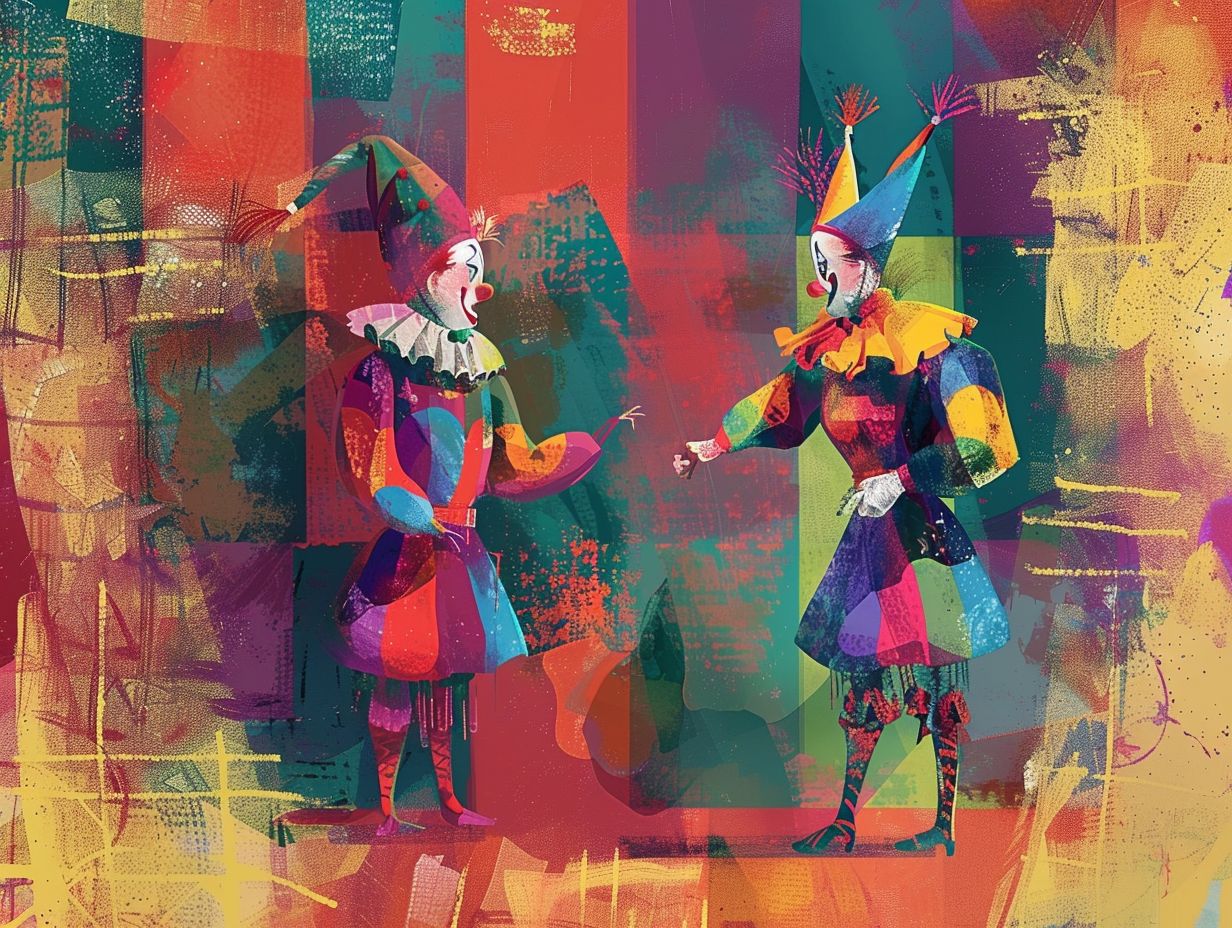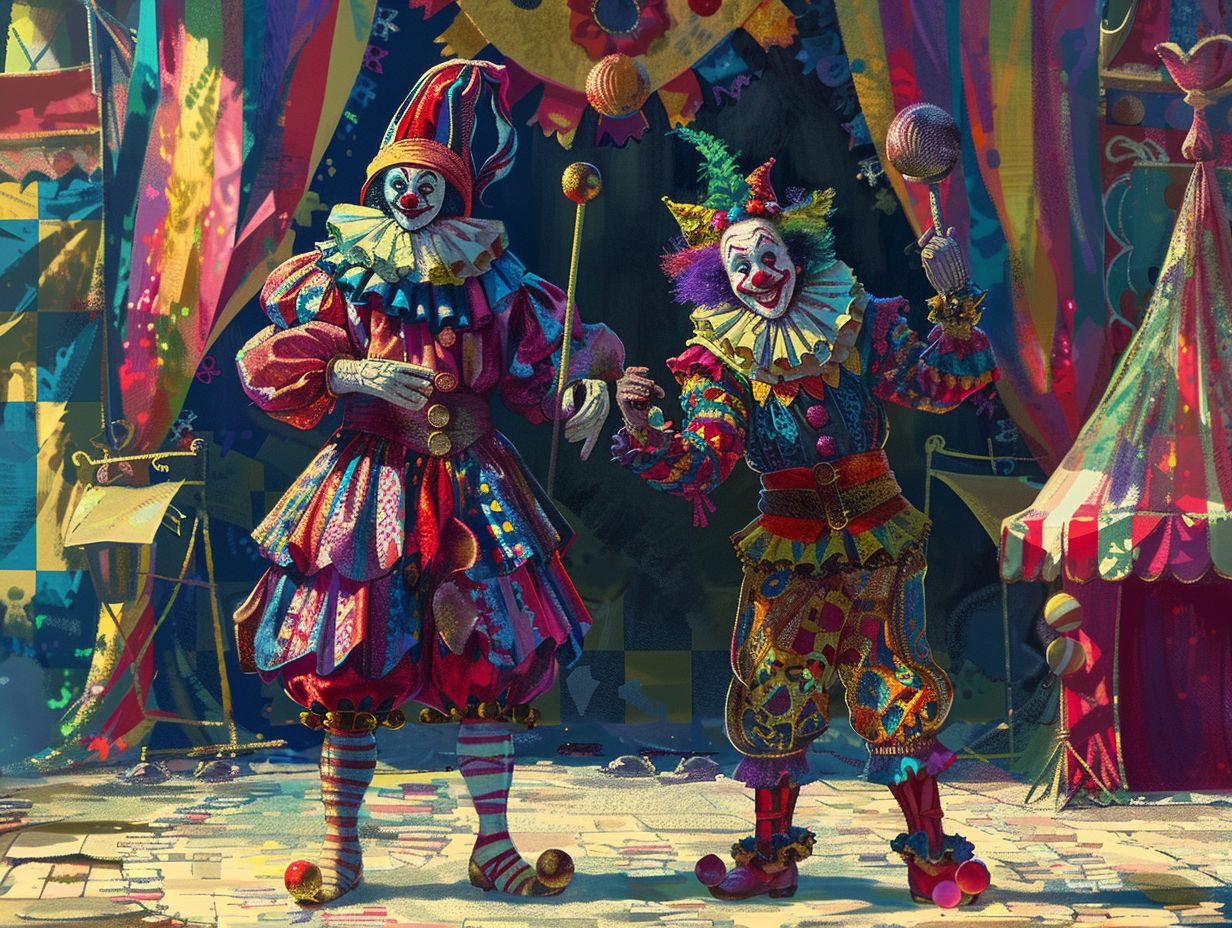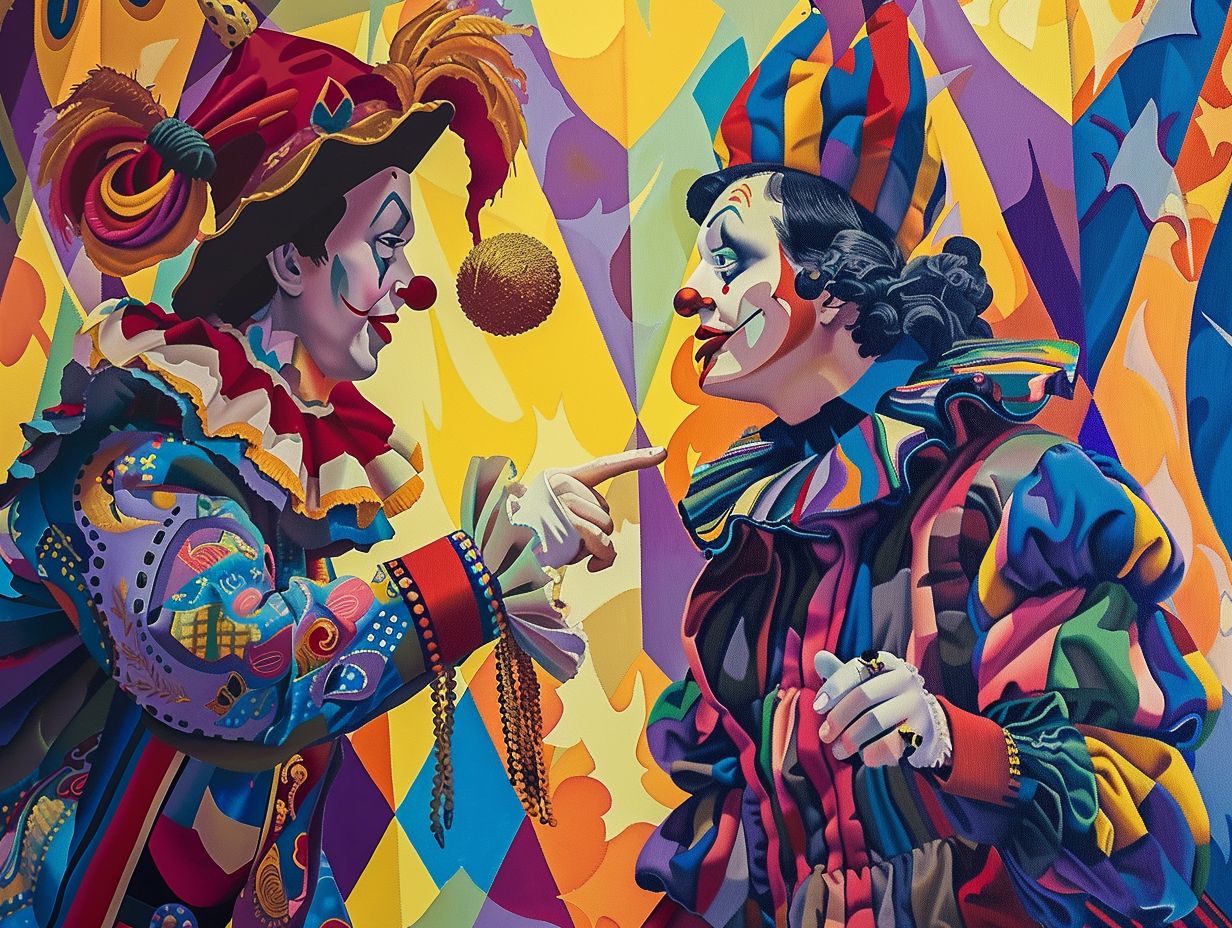Key Takeaways
- Jesters and clowns are both historical entertainers who use humor and wit to entertain their audiences.
- While both wear colorful costumes and makeup, jesters and clowns have different historical origins and perform in different ways.
- Over time, jesters and clowns have evolved in terms of their costumes, performances, and cultural depictions in literature, art, and popular culture.
What is a Jester?
A Jester is a historical entertainer known for their comedic performances and colorful attire. They have a long-standing tradition in various cultures, dating back centuries.
In medieval times, jesters played a crucial role in entertaining royalty and nobility, using their wit and humor to provide much-needed comic relief.
These court jesters were often granted special privileges and were allowed to speak freely, providing social commentary disguised as jokes.
Through the ages, jesters evolved from mere entertainers to advisors and confidants to monarchs. Joseph Grimaldi, the famous English clown, revolutionized the role of jesters in the 19th century by introducing physical comedy and slapstick humor.
Archibald Armstrong, known as the ‘King’s Jester’ in the court of King James I of England, was renowned for his sharp wit and satirical jibes.
He used humor to criticize societal norms and challenge authority, pushing the boundaries of what jesters were permitted to say.
History of Jesters
The history of jesters is rich and diverse, spanning across different eras and cultures.
From the courts of medieval kings to the modern circus, jesters have entertained audiences with their humor and wit.
In ancient civilizations, jesters, also known as court jesters or fools, held significant roles in royal courts, blending entertainment with social commentary and satire.
These colorful characters wore eccentric costumes and masks, engaging in comedic performances to amuse nobility and commoners alike.
Over time, jesters evolved from being entertainers to serving as confidants and advisors to monarchs, utilizing their comedic talents to convey serious messages in a light-hearted manner.
Role of a Jester
The role of a jester is multifaceted, combining elements of comedy, satire, and performance to entertain audiences.
Jesters use humor and wit to engage with their viewers and provide a light-hearted form of entertainment.
They are known for their quick thinking, improvisational skills, and ability to interact dynamically with the crowd.
Whether it is delivering a clever one-liner, performing acrobatics, or juggling, jesters are versatile entertainers who keep the audience captivated.
Adaptability is key in their profession as they must tailor their acts to suit different audiences and venues, ensuring that their performances remain engaging and relevant.
In historical times, jesters played crucial roles in social gatherings, offering comic relief, social commentary, and sometimes even serving as the voice of reason amidst the chaos of the court.
What is a Clown?
A Clown is a performer known for their comedic acts, exaggerated makeup, and colorful costumes. They are a staple in circuses, comedy shows, and various entertainment events.
Clowns often utilize physical comedy, engaging in slapstick routines, pratfalls, and funny gestures to induce laughter from their audience.
Physical comedy plays a crucial role in their performances, requiring skilled timing, agility, and creativity. This form of entertainment has a rich history, with roots dating back to ancient civilizations.
Over time, clowning has evolved, incorporating elements of improvisational comedy and interactive performances to engage modern audiences.
Notable clowns like Emmett Kelly and Red Skelton have made significant contributions to the art form, influencing generations of performers.”
History of Clowns
The history of clowns is deeply rooted in the world of circuses and street performances. Clowns have evolved over time, adapting their acts to different audiences and cultural contexts.
Origins of clowning can be traced back to ancient civilizations like Ancient Egypt and Rome, where performers entertained crowds with exaggerated gestures and comedic routines.
It was during the Renaissance period that clowning as we know it today truly began to take shape.
In the 19th and early 20th centuries, famous clowns like Joseph Grimaldi and Emmett Kelly brought clowning to the forefront of entertainment, paving the way for modern clowns to express themselves through physical comedy and slapstick humor.
Role of a Clown
Clowns play a crucial role in providing laughter and amusement to audiences through their performances.
Their use of makeup and costumes helps create distinctive characters that resonate with viewers.
Clown performances encompass a wide range of styles, from slapstick comedy that involves exaggerated, physical humor to the skilled art of juggling and acrobatics that showcase precision and dexterity.
These diverse skills allow clowns to entertain audiences of all ages through a combination of humor and talent.
The origins of iconic clown characters like Harlequin and Pierrot date back to centuries-old theatrical traditions.
Harlequin, known for his colorful costume and mischievous nature, represents the witty and agile trickster, while Pierrot, with his white face and melancholic demeanor, symbolizes innocence and vulnerability.
These characters have left a lasting impact on the world of entertainment, influencing modern clown acts and embodying various traits and personalities that continue to captivate audiences worldwide.
Similarities between Jesters and Clowns

Jesters and clowns share common traits as entertainers, utilizing humor, colorful costumes, and engaging performances. Both bring joy and laughter to audiences through their comedic acts.
While jesters historically served royal courts and used satire to comment on societal issues, clowns typically perform in circuses or theaters focusing more on physical comedy and slapstick humor.
Jesters were skilled in juggling, acrobatics, and music, often incorporating riddles and wordplay into their routines.
In contrast, clowns often rely on exaggerated gestures and facial expressions to elicit laughter.
The comedy of clowns tends to be more universal and accessible, appealing to a broader audience demographic.
Both Entertainers
Both jesters and clowns are entertainers who captivate audiences with their humor and antics. They bring smiles and laughter to people of all ages through their engaging performances.
Through a mix of physical comedy and verbal wit, jesters and clowns craft their unique brand of entertainment.
Whether it’s juggling, slapstick humor, witty banter, or spontaneously interacting with spectators, these performers create an immersive experience that keeps the audience hooked.
In historical settings, jesters were valued members of royal courts, entertaining nobles and commoners alike with their diverse skills.
The tradition of jesters and clowns has evolved over centuries, adapting to different cultures and audiences while maintaining its essence of spreading joy and mirth.
Use Humor and Wit
Humor and wit are essential elements of both jesters and clowns’ performances. They rely on clever wordplay, physical gags, and comedic timing to engage their audiences and elicit laughter.
One common form of humor used by jesters and clowns is puns, where a play on words creates a humorous effect. Jokes, often laced with irony and sarcasm, are another staple.
In addition, physical comedy involving pratfalls, pie-throwing, and exaggerated movements adds a visual aspect to their performances, creating laughter through slapstick humor.
Satire plays a significant role in their acts, allowing them to cleverly comment on societal issues and norms.
By exaggerating or twisting reality, jesters and clowns use satire to deliver subtle social commentary, making their performances not just entertaining but thought-provoking as well.
Wear Colorful Costumes and Makeup
Both jesters and clowns don vibrant and eccentric costumes, complemented by elaborate makeup that helps define their characters and personas.
Their appearance adds to the visual spectacle of their performances.
These costumes and makeup play a pivotal role in the overall portrayal of jesters and clowns, as they serve as symbolic representations of their character traits and the essence of their performance.
Costumes often feature bright colors and mismatched patterns, reflecting the whimsical and playful nature of these entertainers.
The makeup choices, characterized by exaggerated features like oversized smiles or colorful designs, not only enhance their facial expressions but also emphasize their comedic and exaggerated personas on stage.
Differences between Jesters and Clowns
While jesters and clowns share similarities, they also have distinct differences in their historical origins, performance styles, costume choices, and modern interpretations.
Beginning with jesters, these witty performers were prominent during medieval times, often found in royal courts and households, employing satire and humor to entertain nobility with their quick wit and satire.
On the contrary, clowns emerged in the 18th century as circus entertainers, known for their exaggerated facial expressions, slapstick humor, and colorful costumes that often include oversized shoes and red noses, appealing to a wider audience with their physical comedy and whimsical antics.
Historical Origins
Jesters and clowns have distinct historical origins rooted in different cultural traditions and performance contexts.
Jesters were prevalent in royal courts, while clowns emerged as popular circus performers.
Originating in ancient civilizations, jesters were entertainers who used humor, music, and acrobatics to entertain royals and common folk alike.
In medieval Europe, court jesters were valued for their quick wit and ability to satirize social norms, sometimes even delivering harsh truths disguised as jokes.
Meanwhile, clowns, stemming from the Italian commedia dell’arte tradition, were characterized by their colorful costumes, exaggerated makeup, and slapstick humor, captivating audiences with their physical comedy and improvisational skills.
Performances
Jesters and clowns differ in their performance styles and comedic techniques. Jesters often utilized satire and wordplay, while clowns focused on physical comedy and visual gags.
Regarding jesters, their performances were characterized by quick wit and clever wordplay, often poking fun at societal norms and hierarchies.
They relied on their sharp tongues to deliver humor that made audiences reflect on deeper issues in a lighthearted manner.
In contrast, clowns embraced slapstick humor and exaggerated physical gestures to elicit laughter.
Their acts often involved playful clumsiness, oversized props, and hilarious mishaps that brought joy through visual comedy.
Costume and Makeup

The attire and makeup of jesters and clowns serve distinct purposes in defining their characters. Jesters often wore elaborate courtly costumes, while clowns adopted exaggerated looks with bold makeup.
Costumes and makeup play a crucial role in the performance of jesters and clowns, enabling them to convey their unique personalities and engage with the audience on a deeper level.
Jesters’ ornate outfits, adorned with vibrant colors and intricate patterns, reflected their whimsical and mischievous nature, adding a touch of sophistication to their acts.
In contrast, clowns’ exaggerated features, such as oversized shoes and bright red noses, emphasized their comedic and playful demeanor, eliciting laughter and amusement from viewers.
The distinct visual representations of jesters and clowns, exemplified by iconic figures like Harlequin and Pierrot, contribute to the enduring charm and allure of these beloved entertainers.
Modern Interpretations
In contemporary times, jesters and clowns have undergone reinterpretations to suit evolving audience tastes and entertainment trends.
Modern interpretations of jesters and clowns reflect changing societal norms and humor preferences.
These age-old characters, once confined to royal courts and medieval festivals, have now found new life on screens and stages worldwide.
Contemporary entertainment mediums, such as film, theater, and television, have embraced the whimsical nature of jesters and clowns, incorporating them into a variety of genres and narratives.
From comedic relief in blockbuster movies to central figures in avant-garde theatrical productions, jesters and clowns continue to captivate audiences with their unique blend of comedy, satire, and charm.
How have Jesters and Clowns Evolved over Time?
The evolution of jesters and clowns spans centuries, marked by changes in costume designs, makeup styles, and performance techniques.
These entertainers have adapted to shifting cultural landscapes and audience preferences.
Originally, jesters and clowns served as comic relief in royal courts, clad in vibrant attire and employing physical comedy to entertain the elite.
Over time, as societal structures transformed, jesters and clowns gained popularity among broader audiences, incorporating satire and social commentary into their acts.
In the modern era, these performers have diversified their roles, appearing in various forms of entertainment beyond traditional circus settings, such as movies, TV shows, and even advertising campaigns.
Changes in Costume and Makeup
Over time, jesters and clowns have seen transformations in their costume designs and makeup applications.
The traditional garb of jesters has evolved into more modern interpretations, while clowns have experimented with diverse looks and styles.
For jesters, originally known for their vibrant motley attire featuring colorful patterns and oversized collars, the transition in costume styles can be traced back to the medieval and Renaissance periods.
Instead of the conventional patchwork of fabrics, jesters started incorporating more tailored and structured pieces, reflecting the changing tastes of the elite audiences they entertained.
Meanwhile, clowns began exploring a range of makeup techniques, moving from exaggerated features to intricate designs that highlighted their theatrical expressions in circus performances.
Changes in Performance Styles
The performance styles of jesters and clowns have evolved to encompass a wide range of comedic techniques and entertainment approaches.
From traditional acts to modern adaptations, jesters and clowns have diversified their performances to engage contemporary audiences.
This evolution can be traced back to the early days of jesters and clowns, where their primary role was to entertain royal courts through physical comedy, slapstick humor, and witty improvisation.
As entertainment preferences shifted over time, jesters and clowns adapted by incorporating satire, social commentary, and even circus skills into their repertoire.
Changes in Perception and Stereotypes
The perception of jesters and clowns has shifted over time, influenced by changing cultural attitudes and societal portrayals.
Stereotypes associated with jesters and clowns have evolved, reflecting broader transformations in media and entertainment representations.
Historically, jesters and clowns were often seen as whimsical entertainers, bringing laughter and light-heartedness to royal courts and circuses.
As society progressed, these characters began to take on more complex roles in narratives, sometimes representing deeper societal issues or serving as meta-commentary on the absurdity of life.
Modern portrayals of jesters and clowns in literature, film, and television have delved into darker themes, challenging traditional perceptions and pushing boundaries of comedy and drama.
Cultural Depictions of Jesters and Clowns
Jesters and clowns have left a lasting imprint on various cultural expressions, appearing in literature, art, and popular culture around the world.
Their colorful characters and comedic personas have resonated with audiences across different countries and traditions.
From the witty court jesters in Shakespearean plays to the whimsical circus clowns bringing joy under the big top, these characters have evolved over time but maintained their essence of humor and satire.
Even in modern times, we see echoes of their influence in stand-up comedy, humorous movies, and even marketing campaigns.
Through their antics and performances, jesters and clowns continue to captivate audiences and serve as timeless symbols of amusement and commentary on the human experience.
In Literature and Art

Jesters and clowns have been recurring figures in literature and art, symbolizing comedic relief, social critique, and whimsical performances.
From Shakespearean plays to modern novels, jesters and clowns have inspired diverse narratives and creative expressions.
Within the realm of literature, jesters and clowns often serve as multifaceted characters, encapsulating both humor and depth.
They can represent societal norms, challenge authority, or offer profound insights masked in jest.
In artistic representations, jesters’ colorful attire and exaggerated gestures highlight their role as entertainers and truth-tellers, often revealing truths that may be too uncomfortable to address directly.
In Pop Culture
Jesters and clowns have made enduring appearances in popular culture, becoming iconic symbols of humor, mischief, and entertainment.
Their presence in films, television shows, and advertisements has solidified their status as beloved and recognizable characters.
Their colorful costumes, exaggerated makeup, and playful antics have captivated audiences for generations, with modern adaptations often adding a darker, more complex twist to these traditional figures.
In media franchises like DC Comics‘ Joker or Pennywise in Stephen King’s ‘It,’ jesters and clowns are portrayed with a blend of comedy and horror, appealing to diverse audiences seeking both laughter and a thrill.
In advertising campaigns, these characters are used to evoke nostalgia, whimsy, or even a touch of subversion, tapping into the psychological depths of consumer behavior.
In Different Countries and Cultures
Jesters and clowns have transcended national borders and cultural boundaries, finding resonance in diverse countries and communities worldwide.
Their universal appeal as entertainers has led to varied interpretations and adaptations in different cultural settings.
The historical roots of jesters and clowns date back to ancient civilizations, where they played pivotal roles in court entertainment and social commentary.
From the European courts of medieval times to the vibrant festivities of Asian cultures, these whimsical characters have evolved to reflect the values and narratives of their respective societies.
While jesters were known for their wit and satire, clowns have taken on roles ranging from comedic performers to poignant symbols of society’s complexities.
Frequently Asked Questions
What is the difference between a jester and a clown?
A jester is a comedic performer who entertained the royal court, while a clown is a performer who entertains in a circus or at events. Jesters were known for their wit and cleverness, while clowns are known for their physical humor and antics.
Did jesters and clowns wear different costumes?
Yes, jesters typically wore brightly colored, patterned clothing and a hat with three points, while clowns wear colorful, oversized clothing and a red nose.
Were jesters and clowns both considered funny?
Yes, both jesters and clowns were expected to be funny and make people laugh. However, their styles of comedy and performances differed.
Were jesters and clowns considered respected roles?
Jesters were often seen as valuable members of the royal court, as they could entertain and amuse the king or queen. Clowns, on the other hand, were often viewed as low-status performers until the modern era.
Did jesters and clowns have different roles in society?
Yes, jesters were often seen as entertainers for the elite and were expected to be quick-witted and skilled at wordplay. Clowns, on the other hand, have traditionally been performers for the masses and were known for their physical comedy and stunts.
Are jesters and clowns still relevant today?
While jesters are no longer a part of modern society, clowns are still a popular form of entertainment. However, their roles have evolved and they are now seen in a variety of settings such as circuses, parties, and even horror movies.
